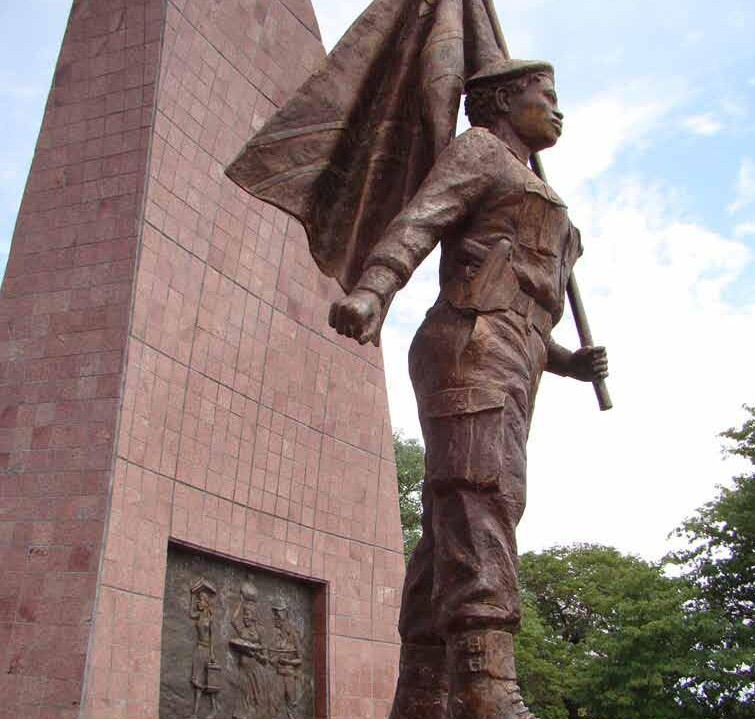Roof of Namibia

Total distance: 467km
Suggested time period: 1½ – 3 days
The Roof of Namibia Experience links the great Kunene River (at Ruacana Falls) and the Okavango River (Nkurunkuru) by following the northern-most part of Namibia through an array of salt pans and ‘fundja’ (flooded channels that move southward from Angola towards the Etosha salt pan). This route is tarred from the east to the west.
Travelling along the Roof of Namibia Experience, travellers will be able to enjoy the feeling of a rural landscape while experiencing the vibrancy of a bustling African market. With a keen interest in Namibia’s recent history, travellers can enjoy attractions such as the Outapi War Museum, Ombalantu Baobab Museum and the Eenhana Shrine.
Attractions:
Ruacana Falls
- Ruacana Falls is located near Ruacana on the Kunene River in Northern Namibia. The waterfall is 120m high and 700m wide in full flood. It is among the largest waterfalls in Africa, both by volume and width. The Ruacana area boasts some beautiful rock formations, with rich textured colouring the landscape and contrasting the lush river with the arid desert to the south. The landscape is further complemented by an array of trees, including the regal baobab, acacia and fever tree. Spectacular sunsets and a wonderful array of birdlife form part of the Ruacana area. To access the falls, travellers need to head towards the border post with Angola, notify the officials that they are visiting the falls and then proceed through to the car park. It should be noted that the parking area is often littered and not well maintained. In addition, due to the hydropower station, the falls are not in full flood for most of the year round.
Ombalantu Baobab Tree Heritage Centre
- 'Omukwa waaMbalantu' the tree of life, as the people of Ombalantu know their baobab tree, played a significant role in local history. The hollow trunk of this huge tree has, at various times, been used as a hideout, a post office, a chapel, and was integrated into the South African military base. The tree can accommodate up to 30 people. Information displays in front of the tree's entrance give a short overview of the tree's diverse history, its role in the Owambo community and the struggle for independence from South Africa in North Central Namibia. The centre also has a renovated 'Koffeehuys' (coffee shop), built and used by the South Africans during the colonial times. The craft shop offers a wide range of wire products, from replicas of the baobab tree to wire giraffes, but also traditional Owambo baskets and clay pots. In the shadow of the baobab tree, travellers will find the ideal spot for a picnic at any time of the day. The kiosk offers barbeque grills for rent and wood for sale to have your own private braai (barbeque) under the tree. For travellers who like to relax after a well-prepared meal, the centre features four private camp sites, each with its own braai (barbeque) place and water tap and communal ablution facilities.
Outapi War Museum
- Outapi War Museum is located underground in the former South African Amy Base situated within Outapi, previously known as 'Ohatopi'. The base was built in 1975 and became home to thousands of South African conscripts stationed on the border during the War on Independence, which lasted from 1966 until 1989, making it one of Africa's longest conflicts. The museum contains a conference hall, Internet cafe, bed-and-breakfast accommodation, refreshment area with a restaurant, gymnasium with a swimming pool as well as a display featuring war material.
Eenhana Memorial Shrine
- Eenhana is the capital town of the Ohangwena Region on the border of Angola. Before Namibian independence it was a military centre of the South African Defence Force without public infrastructure. It was proclaimed a settlement in 1992 and a town in 1999. The name Eenhana comes from the word calves in the Oshikwanyama language and is a reference to the calves that used to drink at the small water pan where Eenhana is now located. Eenhana is the location of at least five mass graves of SWAPO resistance fighters that date back to the Namibian War of Independence from South Africa. In 2008 the government built the Eenhana Memorial Shrine for the lives lost in the liberation struggle.
Ombupupu Pond and Okahao Baobab Heritage Site
- Okahao held great importance within the local Ongandjera Kingdom. Okahao Village was a place of magic, or “iinonoma” because of the Ombupupu pond. Permission to use its water had to be sought from the ancestors. The pond was also used as a ballot box for the election of a new Ongandjera king. Candidates would search within the pond for a hidden clay pot and the victor was nominated as the new king of the Ongandjera Kingdom. An iconic baobab tree has become a heritage site dedicated to those who lost their lives during the War of Independence. It has various attractions, including a craft shop and restaurant.
Businesses in the Area
6 Listings Found



